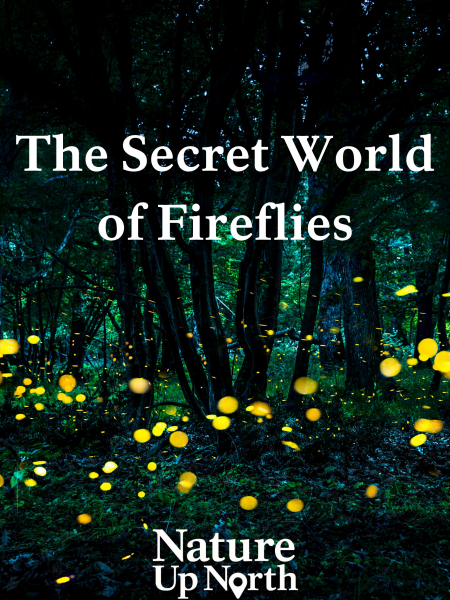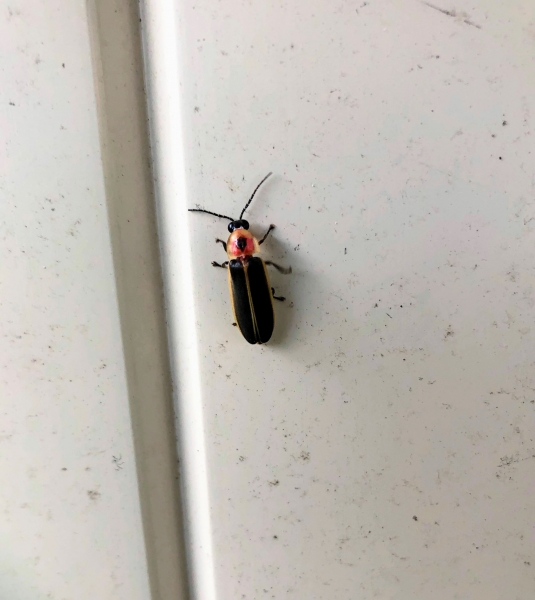



The Secret World of Fireflies
If you look outside on a warm North Country summer night, you’re likely to see tiny blinking lights floating through the sky, disappearing and then reappearing a few feet away. These fireflies (Lampyridae) are not made of fire nor are they flies! They’re actually a member of the beetle order, Coleoptera, the largest known order of organisms in the world with over 350,000 beetle species described and upwards of a million or more species still predicted to be undiscovered. The Lampyridae family has over 2,000 described species of soft bodied beetles known as fireflies, glowworms, or lightning bugs, because of their bioluminescence ability. There are about 170 species of fireflies in the United States and Canada, and the ones we are most used to seeing in the North Country are Photinus pyralis, or the Common Eastern Firefly/Big Dipper Firefly.
How can you tell that a firefly is a firefly?
Fireflies have some interesting anatomy; the first being their soft, flexible forewings, which are called elytra. This is the first way in which they differ from most beetles, which generally have hard elytra. Fireflies start out as larvae, which, just like the adults, are nocturnal, which means they are active at night. The larvae live in the soil and feed on other ground dwellers such as snails, worms, or slugs. Some firefly larvae species can glow just like the adults, and are referred to as “glowworms.” Just like all insects, adult fireflies have three body parts - a head, thorax, and abdomen and they have six legs. The Common Eastern Firefly, the one we know and love in the North Country, has a red plate with a black spot that partially covers its head, and dark brown wing covers outlined in yellow which cover two pairs of wings and their abdomen. What makes fireflies most unique, however, is the last segment of their abdomen, which flashes a yellow-green “cold-light.” See the Common Eastern Firefly coloring page attached at the bottom of the page to color a Photinus pyralis and learn more about their anatomy!
Now that you know what they look like, where can you find fireflies?
Fireflies like warm, damp areas such as the Eastern Americas or different regions of Asia. There are 2,000 species of fireflies worldwide, but, because of specific habitat needs they are not found just anywhere, and not all firefly species actually light up. The North Country is a region lucky enough to have fireflies that do glow on summer evenings, but if you drive a few days to the American West, you’ll be hard pressed to find any, as the climate is far too arid. You’re likely to find them in forests or fields or the margins in between the two habitats. They especially like standing water, such as ponds, marshes, slow streams, or lakes. Fireflies love long grass, which is why if your lawn is overgrown there may be far more than normal flitting about at night. Fireflies are nocturnal creatures, which means that they are active at night. During the day they’ll sleep on the ground, then once dusk comes and night falls they’ll crawl to the top of grass blades or fly onto the ends of tree branches and signal to mates.
So how can you make sure that your backyard is perfect for firefly spotting?
The first, and easiest, thing to do is to quit mowing the grass down so often! Easy! If you don’t want grass up to your knees, then you can also just mow less frequently, as that will decrease the number of fireflies killed that are resting on the ground. Or, if you don’t want your entire backyard to be a hayfield, you can let the edges or just a section of your yard grow tall. Any amount of “wildness” will help increase the biodiversity of the area and the firefly population! If you’re ready for more intensive remodeling, consider adding a small pond to your yard. Fireflies also love standing water, as that is where they mate and congregate. Planting native pine trees can create a habitat that fireflies love, with the thick canopies blocking artificial light, and fallen needles creating great beds for larvae to grow. If altering your yard is out of the question, the simplest thing you can do is turn off your outdoor lights, as they can outshine the fireflies and may interfere with the lighting patterns that are an important part of firefly mating behavior. Implementing one, or all, of these different ideas will make your home a firefly haven!
But what do they eat? And how long do they live?
The adult fireflies we are used to seeing flitting about at night only live for about three to four weeks; whereas, the rest of the firefly life cycle can take up to two years! Adults lay their eggs in mid-summer and, after about three weeks, the eggs hatch into larvae. Larvae then spend between one and two years developing! That means that they overwinter in the soil through freezing cold North Country winters for 50 to 102 weeks until they emerge as pupa. Then they spend about three weeks in the pupa stage until they are fully grown. These larvae are important predators, preying on worms, slugs, and snails by injecting them with a numbing fluid. Some of their prey are agricultural pests, which makes firefly larvae beneficial to have in gardens and fields. Scientists are unsure of what exactly adult fireflies eat, but they hypothesize that nectar or pollen may be possible food sources. Another hypothesis is that some fireflies may not eat at all due to their short lifespan. One interesting thing they observed is female fireflies eating the males of other species. The genus photuris mimics the female flashes of the genus photinus, which attracts the males of that genus, which are then eaten by the photuris! A tad gruesome, but one of the very few instances of this, and adult fireflies haven’t been seen feeding on other insects. Not only are fireflies predators, but they are also prey, mostly to amphibians such as frogs and some species of birds. They are not eaten often, however, due to their glow, which most likely tells predators “Hey! I taste really bad! You don’t want to eat me!”
What is really neat though, is that they glow. How do they do that?
One of the most interesting things about fireflies, their ability to glow, called bioluminescence, has remained a mystery to science until recently. Fireflies produce cold light, which is light given off with nearly 100% of energy being given off as light. In comparison to this, an incandescent light bulb gives off about 10% of its energy as light and the other 90% as heat. Bioluminescence is a relatively rare ability in living organisms, which makes it even cooler that we have a bioluminescent animal right here in the North Country. The way they do it is with a little chemistry: they mix a chemical called luciferin with enzymes called luciferases, then they add some oxygen and, finally, ATP, which is the fuel for cellular processes. They do all of this in the last few sections of their abdomen, and it’s believed that they can control the flashing by regulating the amount of oxygen that is going into that area of the abdomen. The mechanics of it all haven’t yet been discovered. Although bioluminescence is certainly a predatory defense, it is also used as a way to find mates. All firefly species have their own unique signaling system, and males fly around at night flashing a specific pattern. The females are waiting on the ground, and when they see a male of the same species making a nice flashing pattern they will flash back, and then the male will fly down to the ground to meet the female.
There is also one species of firefly in North Carolina called the synchronous firefly, and they are the only known species of firefly in America that can synchronize their flashing. Of the 19 species of fireflies within the Great Smoky Mountains, this is the only one which flashes synchronously. The entire flashing period, which occurs during peak mating season, is not synchronous; rather, there are short bursts of unison flashing followed by periods of darkness. This has become such a popular event for people to see that there is a lottery system to which visitors must apply and be chosen from.
Is there anything threatening fireflies?
Unfortunately, fireflies are facing some difficult times ahead due to a multitude of different threats. Although firefly populations had not been tracked until very recently and exact population sizes are still unknown, it is apparent that firefly numbers are declining. Additionally, it can be a challenge to find and study fireflies when they aren’t displaying, that is, lighting up. One of the biggest threats that firefly experts worldwide say the family is facing is habitat loss. Although some animals can adapt easily to cities and human environments, not all fireflies have proved quite as adaptable. They need specific habitats, mostly to mate and for larvae to overwinter. Another issue fireflies face is light pollution, which can make it difficult to recognize prey, keep track of time or location, and can even disrupt mating. For some species with sensitive eyes, it can even lead to blindness. Interestingly enough, the Common Eastern Firefly, which is the most abundant species in the Northeast, is quite adaptable, and, although it may not be greatly affected by these first two threats, there are hundreds of other species in danger. The human impact that poses the greatest threat to our Common Eastern Firefly is pesticide use. This is because pesticides mostly affect fireflies at the larvae stage and are difficult to avoid and adapt to. Larvae spend one to two years underground, where both they and their prey are directly exposed to pesticides.
Oh no! What can be done to help them?
But not all hope is lost, and there is a lot that we can do to both conserve firefly populations and attract them to your home for your viewing pleasure. The easiest is turning off your lights at night to help in reduction of noise pollution. Reducing the use of pesticides in your yard and gardens is also a great way to ensure that the larvae overwintering in the ground aren’t killed. As mentioned above, creating more wild spaces in your backyard, by mowing your lawn less often or letting parts of it grow long, will help provide suitable habitats for fireflies to hang out, thus increasing their population! While you’re watching, you can also report sightings to Firefly Watch, which will help researchers track firefly populations through citizen science!
To learn more about fireflies, use some of the resources linked below, which include books, websites, and videos appropriate for a range of ages!
-
Books
-
Silent Sparks: The Wondrous World of Fireflies by Sara Lewis
-
Fireflies, Glow-worms, and Lightning Bugs: Identification and Natural History of the Fireflies of the Eastern and Central United States and Canada by Lynn Frierson Faust
-
Fireflies Book: Fun Facts About the Fireflies You Loved as a Kid by Brett Ortler
-
-
Videos
-
The Loves and Lies of Fireflies - TedTalk by Sara Lewis, author of Silent Sparks and renowned firefly researcher
-
Watch: Fireflies Glowing in Sync to Attract Mates | National Geographic
-
-
Website
